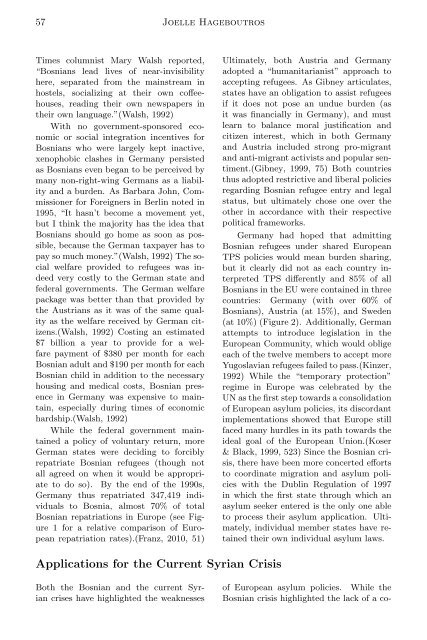Create successful ePaper yourself
Turn your PDF publications into a flip-book with our unique Google optimized e-Paper software.
57 Joelle Hageboutros<br />
Times columnist Mary Walsh reported,<br />
“Bosnians lead lives of near-invisibility<br />
here, separated from the mainstream in<br />
hostels, socializing at their own co↵eehouses,<br />
reading their own newspapers in<br />
their own language.”(Walsh, 1992)<br />
With no government-sponsored economic<br />
or social integration incentives for<br />
Bosnians who were largely kept inactive,<br />
xenophobic clashes in Germany persisted<br />
as Bosnians even began to be perceived by<br />
many non-right-wing Germans as a liability<br />
and a burden. As Barbara John, Commissioner<br />
for Foreigners in Berlin noted in<br />
1995, “It hasn’t become a movement yet,<br />
but I think the majority has the idea that<br />
Bosnians should go home as soon as possible,<br />
because the German taxpayer has to<br />
pay so much money.”(Walsh, 1992) The social<br />
welfare provided to refugees was indeed<br />
very costly to the German state and<br />
federal governments. The German welfare<br />
package was better than that provided by<br />
the Austrians as it was of the same quality<br />
as the welfare received by German citizens.(Walsh,<br />
1992) Costing an estimated<br />
$7 billion a year to provide for a welfare<br />
payment of $380 per month for each<br />
Bosnian adult and $190 per month for each<br />
Bosnian child in addition to the necessary<br />
housing and medical costs, Bosnian presence<br />
in Germany was expensive to maintain,<br />
especially during times of economic<br />
hardship.(Walsh, 1992)<br />
While the federal government maintained<br />
a policy of voluntary return, more<br />
German states were deciding to forcibly<br />
repatriate Bosnian refugees (though not<br />
all agreed on when it would be appropriate<br />
to do so). By the end of the 1990s,<br />
Germany thus repatriated 347,419 individuals<br />
to Bosnia, almost 70% of total<br />
Bosnian repatriations in Europe (see Figure<br />
1 for a relative comparison of European<br />
repatriation rates).(Franz, 2010, 51)<br />
Ultimately, both Austria and Germany<br />
adopted a “humanitarianist” approach to<br />
accepting refugees. As Gibney articulates,<br />
states have an obligation to assist refugees<br />
if it does not pose an undue burden (as<br />
it was financially in Germany), and must<br />
learn to balance moral justification and<br />
citizen interest, which in both Germany<br />
and Austria included strong pro-migrant<br />
and anti-migrant activists and popular sentiment.(Gibney,<br />
1999, 75) Both countries<br />
thus adopted restrictive and liberal policies<br />
regarding Bosnian refugee entry and legal<br />
status, but ultimately chose one over the<br />
other in accordance with their respective<br />
political frameworks.<br />
Germany had hoped that admitting<br />
Bosnian refugees under shared European<br />
TPS policies would mean burden sharing,<br />
but it clearly did not as each country interpreted<br />
TPS di↵erently and 85% of all<br />
Bosnians in the EU were contained in three<br />
countries: Germany (with over 60% of<br />
Bosnians), Austria (at 15%), and Sweden<br />
(at 10%) (Figure 2). Additionally, German<br />
attempts to introduce legislation in the<br />
European Community, which would oblige<br />
each of the twelve members to accept more<br />
Yugoslavian refugees failed to pass.(Kinzer,<br />
1992) While the “temporary protection”<br />
regime in Europe was celebrated by the<br />
UN as the first step towards a consolidation<br />
of European asylum policies, its discordant<br />
implementations showed that Europe still<br />
faced many hurdles in its path towards the<br />
ideal goal of the European Union.(Koser<br />
& Black, 1999, 523) Since the Bosnian crisis,<br />
there have been more concerted e↵orts<br />
to coordinate migration and asylum policies<br />
with the Dublin Regulation of 1997<br />
in which the first state through which an<br />
asylum seeker entered is the only one able<br />
to process their asylum application. Ultimately,<br />
individual member states have retained<br />
their own individual asylum laws.<br />
Applications for the Current Syrian Crisis<br />
Both the Bosnian and the current Syrian<br />
crises have highlighted the weaknesses<br />
of European asylum policies. While the<br />
Bosnian crisis highlighted the lack of a co-


